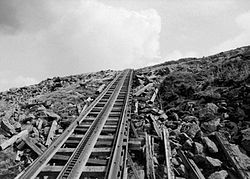Mount Washington Cog Railway

Track with rack
|
|
| Locale | Coos County, New Hampshire, USA |
|---|---|
| Dates of operation | 1868–Present |
| Track gauge | 4 ft 8 in (1,422 mm) |
| Length | 3 miles (4.8 km) |
| Headquarters | Bretton Woods |
| Mount Washington Cog Railway | |
|---|---|
| Technical | |
| Line length | 3 mi (4.8 km) |
| Track gauge | 4 ft 8 in (1,422 mm) |
| Electrification | none |
| Rack system | Marsh rack system |
| Mount Washington Cog Railway | |||||||||||||||||||||||||||||||||||||||||||
|---|---|---|---|---|---|---|---|---|---|---|---|---|---|---|---|---|---|---|---|---|---|---|---|---|---|---|---|---|---|---|---|---|---|---|---|---|---|---|---|---|---|---|---|
|
|||||||||||||||||||||||||||||||||||||||||||
The Mount Washington Cog Railway is the world's first mountain-climbing cog railway (rack-and-pinion railway). The railway is still in operation, climbing Mount Washington in New Hampshire, USA. It uses a Marsh rack system and one or two steam locomotives and six biodiesel powered locomotives to carry tourists to the top of the mountain. Its track is built to 4 ft 8 in (1,422 mm) gauge, which is technically a narrow gauge, as it is a 1⁄2-inch (12.7 mm) less than 4 ft 8 1⁄2 in (1,435 mm) standard gauge.
It is the second steepest rack railway in the world after the Pilatus railway, with an average grade of over 25% and a maximum grade of 37.41%. The railway is approximately 3 miles (4.8 km) long and ascends Mt. Washington's western slope beginning at an elevation of approximately 2,700 feet (820 m) above sea level and ending just short of the mountain's summit peak of 6,288 feet (1,917 m). The train ascends the mountain at 2.8 miles per hour (4.5 km/h) and descends at 4.6 mph (7.4 km/h). It takes approximately 65 minutes to ascend and 40 minutes to descend although the diesel can go up in as little as 37 minutes.
Most of the Mount Washington Cog Railway is in Thompson and Meserve's Purchase, with the part of the railway nearest to Mt. Washington's summit being in Sargent's Purchase.
The railway was built by Sylvester Marsh who grew up in Campton. Marsh came up with the idea while climbing the mountain in 1852. His plan was treated as insane. Local tradition says that the state legislature voted permission based on a consensus that harm resulting from operating it was no issue — since the design was attempting the impossible — but benefits were guaranteed. He was putting up $5,000 of his own money, and that (plus whatever else he could raise) would be spent locally, including building the Fabyan House hotel at nearby Fabyan Station to accommodate the expected tourists. The railway is sometimes called "Railway to the Moon" because one state legislator remarked during the proceedings that Marsh should be given a charter—not merely up Mount Washington but also to the moon.
...
Wikipedia
